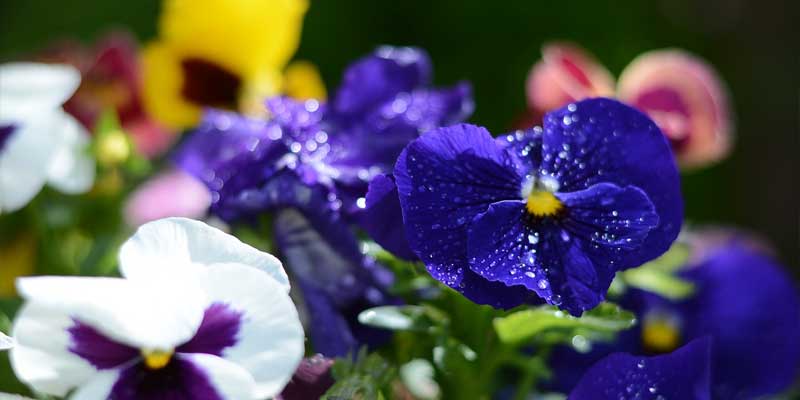Gardeners favor Pansies for their ability to imbue any landscape with charm and beauty, courtesy of their delicate petals and vibrant colors. These resilient flowers thrive in cooler temperatures; thus, whether they adorn flower beds, hanging baskets, or containers, they remain an attractive option. Furthermore – caring for them is relatively straightforward! However, a conundrum often perplexes these green-thumbed enthusiasts—knowing the ideal frequency at which one should water pansies.
This comprehensive guide delves into the intricacies of watering pansies, providing insights into the factors that influence their water needs; furthermore, it offers practical tips to guarantee your pansies flourish.
How Often To Water Pansies
Essential to the health and vibrancy of pansies is a precise determination of their watering frequency. Typically, these flowers reap benefits from regular irrigation when one to three days elapse without moisture contacting their soil.
However, depending on factors such as soil type, weather conditions (including temperature fluctuations), container versus ground planting methods, and plant maturity, this rule may vary significantly.
Regularly monitoring soil moisture and adjusting watering frequency accordingly is a crucial task. To maintain consistent moisture in the soil without waterlogging it. By tailoring your pansies’ watering schedule – thus catering to their unique needs – you can foster thriving growth; indeed, abundant blooms will be rewarded throughout their growing season.
Factors Influencing Watering Frequency
Several factors influence how often pansies should be watered:
1. Soil Type
Pansies thrive in soil that maintains optimal moisture levels without excessive waterlogging: specifically, well-draining soil types are ideal. Sandy soils necessitate frequent watering due to their rapid drainage; on the other hand, clay-based variants retain moisture for extended periods, a quality advantageous to pansy growth.
2. Weather Conditions
Hot, dry weather escalates the evaporation rate and demands more frequent watering; in contrast – cooler temperatures and overcast days potentially reduce this necessity for regular irrigation.
3. Container Planting vs. Ground Planting
Pansies, when cultivated in containers or hanging baskets, often experience accelerated moisture loss compared to their counterparts planted directly in the ground. This is attributable to heightened air and sunlight exposure, intensifying the drying process.
4. Size and Maturity of Plants
Young pansy seedlings, possessing shallower root systems than their established counterparts with deeper roots, demand more frequent watering. The size and maturity of plants directly correlate to their environmental conditions; indeed, young pansy seedlings characterized by shallower root systems compared to established variants with deeper roots will require more frequent watering.
5. Mulching
Applying a layer of organic mulch around pansies – a process known as mulching – aids in the retention of soil moisture; furthermore, it diminishes the need for frequent watering.
Developing a Watering Schedule
The health and vitality of your pansies must establish a watering schedule tailored specifically to their needs. Use this step-by-step guide to create an effective routine.
1. Monitor Soil Moisture
Pansies generally necessitate watering every 1-3 days; this frequency, however, hinges upon the previously mentioned factors. It is essential to modulate the frequency in accordance with prevailing weather conditions and soil moisture levels.
To actively monitor soil moisture, regularly insert your finger into the soil up to the first knuckle; should it feel dry at this depth, take that as a cue to water.
2. Watering Technique
Direct the water towards the soil at the base of pansies, instead of splashing it on their foliage. This method safeguards against fungal diseases and guarantees that roots enjoy sufficient moisture.
3. Deep Watering
Aim to moisten the soil significantly, reaching a depth of 6-8 inches during your watering sessions; this strategy promotes robust root growth. Conversely, shallow watering engenders weak root systems and heightens plant susceptibility to drought stress.
4. Time of Day
In order to minimize the loss of water through evaporation and mitigate potential risks associated with fungal diseases, such as those related to wet foliage overnight, it is best practice for you to engage in early morning or late afternoon watering sessions specifically for your water pansies.
5. Adjusting for Rainfall
Modify your watering schedule during periods of rainfall. Pansies, indeed, thrive with an appreciation for moisture; however, excessive rain may induce waterlogging in the soil and subsequently trigger root rot.
Signs of Overwatering and Underwatering
Recognizing the signs of both overwatering and underwatering is essential for preventing damage to your pansies; this awareness is a crucial aspect of successful gardening.
1. Overwatering: Overwatering manifests through several signs: yellowing leaves, wilting even with moist soil, and a foul odor from the soil all pointing towards root rot.
2. Underwatering: Underwatering manifests as wilting, the leaves become dry and crispy; growth also stunts, indeed, in severe cases of this symptomatology, pansies may entirely cease blooming.
Conclusion
Fundamentally cultivating pansies to success requires mastering the art of watering. Understand their water needs and factors that influence the frequency, and you will ensure your pansies thrive; they will continue gracing your garden with beauty.
If you establish a precise watering schedule – coupled with attentive care – an abundance of colorful blooms throughout each growing season is yours to enjoy. In this manner, you transform your garden into a picturesque haven for both yourself and those delightful pansies.



Leave a Reply